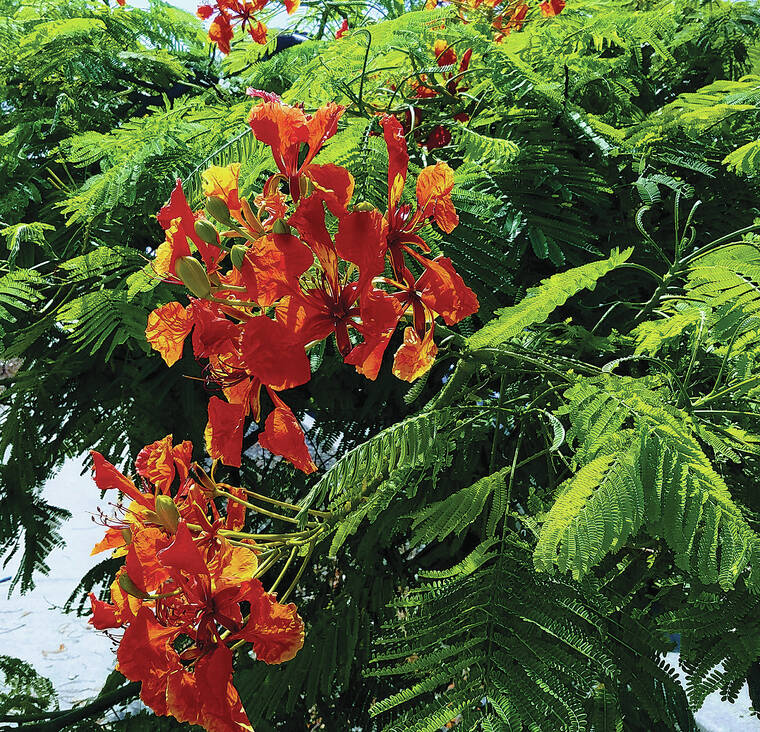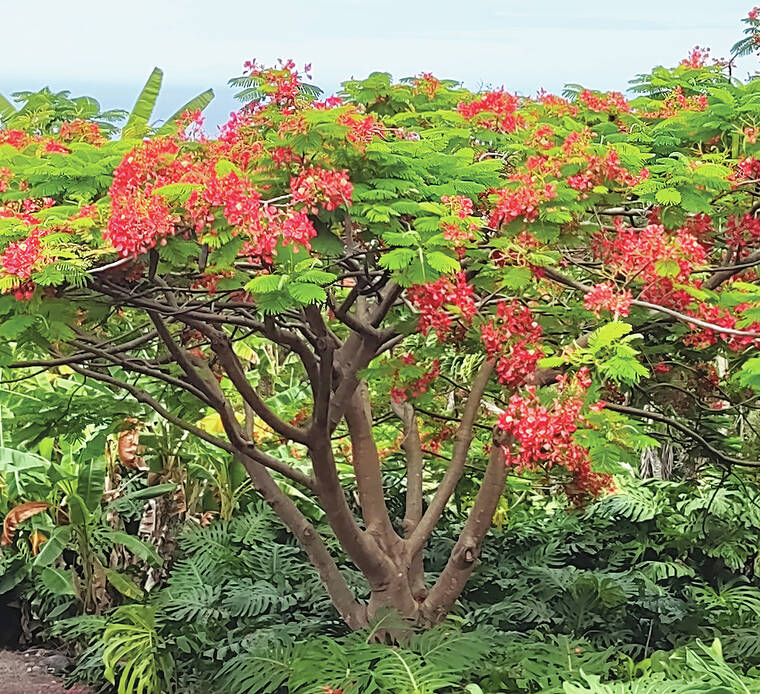Plant of the Month for September 2022: Royal poinciana adds beauty and shade to a tropical landscape

The bright red flowers of the royal poinciana have a single light-colored, speckled petal on each blossom. (Kim and Forest Starr via Diana Duff/Special to West Hawaii Today)

The roots of the royal poinciana grow deep and wide both below and above ground. (Kim and Forest Starr via Diana Duff/Special to West Hawaii Today)

Pruning to lift the canopy reveals the lovely sculptural shape of the royal poinciana’s trunk. (Diana Duff/Special to West Hawaii Today)

The bright red flowers of the royal poinciana have a single light-colored, speckled petal on each blossom. (Kim and Forest Starr via Diana Duff/Special to West Hawaii Today)
A few years ago, I encouraged readers of this column with small yards to plant the dwarf poinciana. Today, a large gloriously blooming royal poinciana just off my Kona lanai begs for my attention, needing to be noticed and described. The tree is a perfect addition to this spacious property. When maintained with a well-pruned base and a large spreading canopy, a royal poinciana offers wonderful beauty and shade to a tropical landscape.
A few years ago, I encouraged readers of this column with small yards to plant the dwarf poinciana. Today, a large gloriously blooming royal poinciana just off my Kona lanai begs for my attention, needing to be noticed and described. The tree is a perfect addition to this spacious property. When maintained with a well-pruned base and a large spreading canopy, a royal poinciana offers wonderful beauty and shade to a tropical landscape.
Known botanically as Delonix regia, royal poinciana is a flowering plant in the fabaceae or bean family. Though native to Madagascar’s dry deciduous forests, this tree is now widely cultivated in many tropical and sub-tropical parts of the world.
The botanical name Delonix is derived from the Greek words “delos” for conspicuous and “onyx” for claw referring to the color and shape of the flower. “Regia” translates directly to royal. The English name “poinciana” honors a French nobleman, Phillippe de Longvilliers de Poincy, who was the governor of Saint Kitts Island in the Caribbean. It is also known there as the flamboyant or flame tree and is the national flower of this island.
Royal poinciana is a fast-growing tree that in optimal conditions can grow nearly 5 feet a year and mature at nearly 40 feet within 10 years. The umbellate canopy can spread beyond 50 feet wide and will be festooned with bright red-orange blossoms all summer. Its large canopy and expansive surface root system demand a location away from pavement or buildings.
Though poincianas will grow in many different soil conditions, they will do best in soil that drains well. They prefer free-draining sandy or loamy soil enriched with organic matter. Heavy or clay soils may limit growth and the trees will flower more profusely when the soil is kept slightly dry. Once established the tree can tolerate some drought and exposure to salt air. For the best flowering, full sun and somewhat dry soil conditions are preferable.
It is the shapely form as well as the showy flowers that make royal poincianas such a wonderful specimen plant in a large landscape. The flowers appear in clusters and range in color from deep red to bright orange. A yellow flowered cultivar, D. flavida is also available.
The trees usually begin their floral display in late spring and can continue to flower heavily into the fall. The individual flowers have spoon shaped petals about three inches long with a single larger petal that may be a lighter color and speckled. Following pollination of the flowers, foot-long green pods appear that are filled with seeds. The pods will turn dark brown and drop when mature.
The foliage is referred to as bipinnately compound and consists of pairs of 20 to 40 primary leaflets that are divided into 10 to 20 secondary leaflets. Overall, the leaves have a delicate fern-like appearance that provide dappled shade to the ground below.
Pruning a royal poinciana when young can help create a solid tree structure. As the tree grows, pruning lower branches and keeping major limbs ten to twelve feet above the ground helps keep the tree strong. You can continue to thin out the branches to keep the tree from becoming too dense and to help restrict its height. Judicious pruning can also help prevent damage to weak limbs in heavy winds. The tree will recover quickly from proper pruning cuts as well as broken limbs.
Early spring is the best time of year to prune, before the spring growth and budding starts. With the lower branches removed, the royal’s smooth gray bark gives this large poinciana a stately, sculptural appearance. With clearance below the tree, ground maintenance is easier and the shady understory can be planted. The raised canopy also allows easy access to fallen seed pods once they mature and drop.
Though the dried pods can be painted or decorated and used as rattles, they also contain at least a dozen viable seeds. To propagate from royal poinciana seeds, collect them from the dried pods and soak them in warm water for at least twenty-four hours. You can also scarify the seeds by clipping the tough outer shell with nail clippers or scissors. Once scarified or soaked, plant them in a moist seeding mix in a shady location. They will usually germinate within a week and in a few weeks can grow to a foot tall.
Propagation by cuttings takes longer but ensures the results will duplicate the parent tree. Cut a foot long section of semi-hardwood branches about the diameter of a pencil. Dust with rooting hormone and place in a moist potting mix. The cuttings may take a few months to root but will grow quickly once they start.
When the seedlings or cuttings seem strong and have developed a good root system, they are ready to place in the landscape. Full sun locations at least forty feet from structures will enable the tree to fill a large area in just a few years. It may take five years or more to mature enough to begin flowering, however.
Poincianas need little maintenance. Growth can be controlled by occasional pruning. They are seldom attacked by insects or diseases. Their roots grow deep and wide so the tree may only need a good watering weekly if rain is rare. As a member of the bean family, poincianas can collect, sequester and use nitrogen from the air to feed themselves. Light fertilization every three months will encourage growth.
It should be noted that the leaves and seeds are mildly toxic to people and pets. If ingested in large quantities, symptoms may include irritation of the mouth, nausea, vomiting and diarrhea. Discourage pets or children from eating any parts of the plant.
If you want instant flowering, buy a potted plant that is already in flower. You may find potted plants in local garden shops or nurseries or you can call Margo at (808) 329-7593 and ask her to find you a good specimen.
If you have the space for a large tree, royal poinciana is an excellent choice. Many people consider it to be one of the most beautiful trees in the world. I think I might agree. It is a dazzling addition to my view and is eye catching wherever it appears throughout Kona during its summer flowering season.
Diana Duff is a plant adviser, educator and consultant living part time in Kailua-Kona.
Gardening Events
Saturdays: “Work Day at Amy Greenwell Garden” from 9 a.m. to 12:30 p.m. Meet at the Garden Visitor Center across from the Manago Hotel in Captain Cook. Come with a mask and be prepared to practice social distancing. Volunteers can help with garden maintenance and are invited to bring a brown bag lunch. Water and snacks provided. Visit the website www.amygreenwell.garden/get-involved/volunteer-1/ and sign up for the weekly email for more information on work days.
Sept. 22: “Mango Workshop” starts at 9 a.m. Available on Zoom and in-person at the UH Cooperative Extension and Research Station in Kealakekua. Discussing mango production in Hawaii, results of research and trials for treating mango diseases and for inducing off-season mangos. Info/register: HawaiiCoffeeEd.com/mango.
Farmer Direct Markets
Wednesday: “Ho’oulu Farmers Market” at Outrigger Kona Resort &Spa
Saturday: “Keauhou Farmers Market” 8 a.m. to noon at Keauhou Shopping Center
“Kamuela Farmer’s Market” 7:30 a.m. to noon at Pukalani Stables
“Waimea Town Market” 7:30 a.m. to noon at the Parker School in Waimea
“Waimea Homestead Farmers Market” 7:30 a.m. to noon at the Waimea middle and elementary school playground
Sunday: “Pure Kona Green Market” 9 a.m. to 2 p.m. at Amy Greenwell Garden in Captain Cook
“Hamakua Harvest” 9 a.m. to 2 p.m. at Highway 19 and Mamane Street in Honokaa
Plant Advice Lines
Anytime: konamg@ctahr.hawaii.edu; Tuesdays and Thursdays from 9 a.m. to noon at UH-CES in Kainaliu at (808) 322-4893. Walk-in from 9 a.m. to noon Mondays, Tuesdays, and Fridays at the UH-CES at Komohana in Hilo or call (808) 981-5199 or email himga@hawaii.edu


